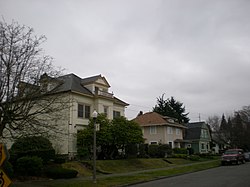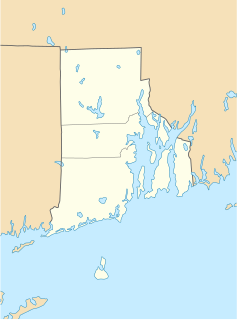North Slope Historic District | |
 Houses on North Slope | |
| Location | Area bounded by Division Ave., N. Grant Ave, N. Steele St., and N I St., Tacoma, Washington |
|---|---|
| Area | 228 acres (92 ha) |
| Architectural style | Late Victorian, Late 19th And 20th Century Revivals, et al. |
| NRHP reference # | 03000160 |
| Added to NRHP | March 28, 2003 |
The North Slope is a neighborhood of the north end of Tacoma, Washington, located south of Yakima Hill.

Tacoma is a mid-sized urban port city and the county seat of Pierce County, Washington, United States. The city is on Washington's Puget Sound, 32 miles (51 km) southwest of Seattle, 31 miles (50 km) northeast of the state capital, Olympia, and 58 miles (93 km) northwest of Mount Rainier National Park. The population was 198,397, according to the 2010 census. Tacoma is the second-largest city in the Puget Sound area and the third largest in the state. Tacoma also serves as the center of business activity for the South Sound region, which has a population of around 1 million.
Contents
Although there is no truly defined boundary for the North Slope, and it often bleeds over into Yakima Hill under some definitions, the area typically is considered to border North I Street on the northeast, Division Avenue on the southeast, and North Steele Street on the west. This area is known as the North Slope because it is both (mostly) at a slope and because the streets within it are at a slant relative to the grid of the rest of North Tacoma. Two streets, North State Street and North Trafton Street, as well as portions of North 8th Street, also may be considered part of the North Slope, with a southern boundary on 6th Avenue.
Sixth Avenue is a cross-town avenue in Tacoma, Washington, which throughout a large portion of the city, provides the division between the north and south numbered streets.
The area has a diverse mix of large houses, apartments, and smaller bungalows. For an area composed largely of detached, single family homes, it is quite urban in character. [1]
Tacoma's North Slope Historic District is a trapezoidal-shaped district bounded by North I Street to the north, Division Avenue to the east, and N Steele Street to the west. North Grant Avenue caps off the south end of the district. The North Slope has 1,285 resources and is one of the state's largest historic districts.
The District was settled primarily as a residential neighborhood and contains a wide variety of architectural styles including Stick Style, Queen Anne, Craftsman, American Foursquare, Tudor Revival, and Mission Revival. Within it you will find many churches, apartments, and a few business areas.
The neighborhood developed over time and it is common to find structures built 20, 30 or even 50 years later.
There were three building booms within the district: 1888 to 1893, 1902 to 1915, and 1919 to 1929. Nearly 80 percent of the homes were built prior to 1930.
Tacoma's North Slope Historic District is a cohesive neighborhood that represents the social and economic history of Tacoma. The district represents a cross culture of individuals — both famous and ordinary — whose skills and talents played a role in the development and growth of the city. The early residents included professionals, trades people, business proprietors, railroad employees, and celebrities — all living in a close-knit neighborhood.
The district embodies the distinctive characteristics of residential development in Tacoma. Many of these dwellings represent the work of master craftsmen and architects. The period of significance for the district runs from 1881 to 1955. In 1955, the City of Tacoma changed zoning laws that allowed some of the neighborhood's older homes to be demolished and replaced by apartment buildings.
Residents of the North Slope Historic District are united by more than their affinity for old homes. The district's board is made up of residents who are dedicated to the betterment of our neighborhood.














